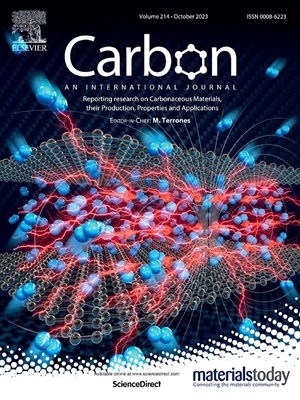Preparation of salt-resistant carbon dots-based nanofluids from coal tar pitch and their properties for enhanced oil recovery
IF 10.5
2区 材料科学
Q1 CHEMISTRY, PHYSICAL
引用次数: 0
Abstract
Nanomaterials are important enhancers for low-permeability reservoir engineering, while conventional nanomaterials still face limitations in size distribution, stability, and environmental compatibility. To address these challenges, the coal tar pitch (CTP), a low-cost by-product of coal chemical industry, was used as a carbon precursor to prepare coal tar pitch-based carbon dots (CTP-CDs, 2.61 ± 0.3 nm) with high stability, graphitized structure, and rich in carboxyl and hydroxyl groups through oxidation and hydrothermal methods, achieving high-value conversion of industrial waste. Structural characterization analysis through Fourier-transform infrared (FT-IR) peak deconvolution, X-ray photoelectron spectroscopy (XPS), and X-ray diffraction (XRD) reveals a carbonization pathway dominated by polyaromatic core condensation and periphery oxidation. The CTP-CDs were further mixed with sodium fatty alcohol polyoxyethylene ether carboxylate (AEC-9Na), which achieved the synergistic enhancement of interfacial activity, wetting control, and enhanced oil recovery (EOR) efficiency. The AEC-9Na/CTP-CDs system (ωCTP-CDs = 0.5, c = 500 mg/L) can reduce the toluene-water interfacial tension to 0.66 mN/m at the salinity of 200,000 mg/L. The mixed system remains stable at the salinity of 300,000 mg/L or pH = 13, and the oil-wet glass contact angle decreases from 106.0° to 64.3°. It enhances oil recovery through the dual mechanism of “oil film removal-emulsification", and the crude oil recovery rate is increased by 17.4 %. This study provides a theoretical basis for the development of carbon-based nanofluids in low-permeability reservoirs and has important engineering value for realizing the resource utilization of coal-based solid waste.

煤焦油沥青制备耐盐碳点纳米流体及其提高采收率性能
纳米材料是低渗透油藏工程的重要增强剂,而传统的纳米材料在尺寸分布、稳定性和环境相容性等方面仍存在局限性。为了解决这些问题,以低成本的煤化工副产物煤沥青(CTP)为碳前驱体,通过氧化和水热法制备了稳定性高、结构石墨化、富含羧基和羟基的煤沥青基碳点(CTP- cds, 2.61±0.3 nm),实现了工业废弃物的高价值转化。通过傅里叶变换红外(FT-IR)峰反褶积、x -射线光电子能谱(XPS)和x -射线衍射(XRD)对其结构进行表征,揭示了以多芳烃核心缩合和外围氧化为主的炭化途径。CTP-CDs进一步与脂肪醇聚氧乙烯醚羧酸钠(AEC-9Na)混合,实现了界面活性、润湿控制和提高采收率(EOR)效率的协同增强。AEC-9Na/CTP-CDs体系(ωCTP-CDs = 0.5, c = 500 mg/L)在盐度为20万mg/L时,甲苯-水界面张力降至0.66 mN/m。混合体系在盐度为300,000 mg/L或pH = 13时保持稳定,油湿玻璃接触角从106.0°减小到64.3°。通过“除油膜-乳化”双重机理提高原油采收率,原油采收率提高17.4%。该研究为低渗透储层中碳基纳米流体的开发提供了理论依据,对实现煤基固体废弃物资源化利用具有重要的工程价值。
本文章由计算机程序翻译,如有差异,请以英文原文为准。
求助全文
约1分钟内获得全文
求助全文
来源期刊

Carbon
工程技术-材料科学:综合
CiteScore
20.80
自引率
7.30%
发文量
0
审稿时长
23 days
期刊介绍:
The journal Carbon is an international multidisciplinary forum for communicating scientific advances in the field of carbon materials. It reports new findings related to the formation, structure, properties, behaviors, and technological applications of carbons. Carbons are a broad class of ordered or disordered solid phases composed primarily of elemental carbon, including but not limited to carbon black, carbon fibers and filaments, carbon nanotubes, diamond and diamond-like carbon, fullerenes, glassy carbon, graphite, graphene, graphene-oxide, porous carbons, pyrolytic carbon, and other sp2 and non-sp2 hybridized carbon systems. Carbon is the companion title to the open access journal Carbon Trends. Relevant application areas for carbon materials include biology and medicine, catalysis, electronic, optoelectronic, spintronic, high-frequency, and photonic devices, energy storage and conversion systems, environmental applications and water treatment, smart materials and systems, and structural and thermal applications.
 求助内容:
求助内容: 应助结果提醒方式:
应助结果提醒方式:


